Illustrations from the Joe Gruber collection as stated.
While most collectors know, including this author, why De Forest made his type T (tubular) audion to meet the competition in 1916, it escapes me why he made it with only 1 filament. De Forest had been trying for several years to prevent west coast makers from infringing on his grid patent, and his own right to make his triode dragging on in the court system made this almost impossible.
Cunningham was making his tubular Audiotron, and Audio Tron, all minor spelling differences to confuse who was actually selling them, all made with 2 filaments. Although Cunningham claimed he made his infringing tube with a single filament, this author has never seen one. It seems around April, 1920, Cunningham made some sort of deal with De Forest and acquired a license to sell his Audiotron and ads to appeared in the Pacific Radio News magazine. In one of his last ads to appear marketing his original Audiotron tube in November, 1920, Cunningham had 3 different named tubes, the original Audiotron now called a detector, the Amplitron as a amplifier, and the Ociltron as a oscillator.
The Electron Audio, made by the Electron Manufacturing Company of Philadelphia, made a similar tube to the Audiotron and claimed it was formally called the Audio Tron. This could actually be a purchased Cunningham Audiotron and then re-branded the Electron Audio, again, made with a double filament. No one is sure!
The Oscilaudion, Thermo Tron, and Liberty Valve were sold by Harry V. Roome, and it quite possible, again, that he purchased double filament Audiotrons from Cunningham, re-labeled them with a new name, upped the price a bit and sold them, again with 2 filaments. It seems, when investigated, Harry was found to be a high school aged boy selling the tubes from his home in Los Angeles. His father, William Roome, apperars to have been an electrical engineer so he may have been part of the plot to market tubes and a few other apparatuses.
The National Electric Manufacturing Co. in Chicago, offered a double- double filaments tube called the Tigerman with what looks like external grids on each of the double sides. While these tubes look impressive, they probably did not work at all.
Otis Moorhead and his Pacific Laboratories Sales Department did his share to confound De Forest with his double filament Electron Relay. Moorhead included his name and address on his ads which Was quite bold of him.
The Radio Apparatus Company of Pottstown, PA sold a control box for tubular type tube but it is unclear if they made the tube as well. Probably not.
The Pacific Wireless Specialty Company sold control boxes using infringing tubular tubes purchased from 1 of the makers?
Several other companies could have made tubular type tubes but this author is un-aware of them.
De Forest could not stop the infringers so it appears he reasoned that he would beat the competition by making his own type T tubular tube. It must have been quite clear to him that he was selling his type T at the same price as his competitors at $5.50 but with a single filament instead of a double. It must have also been clear to amateur buyers that the best deal were the double filament tubes. It did not help when De Forest waived his normal tube sales tactics that meant buying a tube, whether tubular or spherical, came with the stipulation of also purchasing the control box as well. Buyers could then buy the type T audions without the extra cost of the equipment just to buy another tube. If De Forest dropped his price a bit, his competitors would too so he could not compete. This author can only speculate as to why. It is difficult to see inside the tubes but it may be that De Forest used 1 tantalum filament and it would be too expensive to add a second. His competitors may have used tungsten for their filaments to keep the cost down but they suffered in their output of electrons. The C-16 De Forest bulletin does not state what the filaments are made of so a guess is necessary. In any case, De Forest must have hurt his sales by introducing a single-filament tubular tube when his competition had double- filaments tubes at his price or a lower price? Soon, around 1920, De Forest was going to move on to bigger and better opportunities that had been brought about by the end of WW1 and the many changing facets of the industry.
Click on pictures below for a larger view.
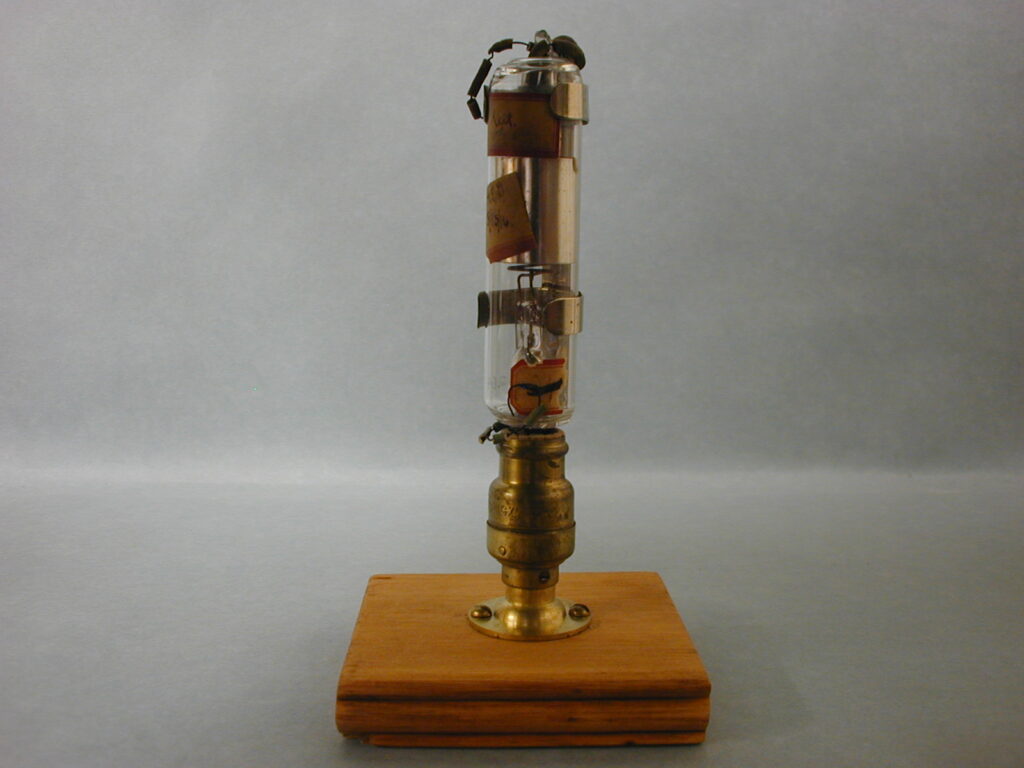
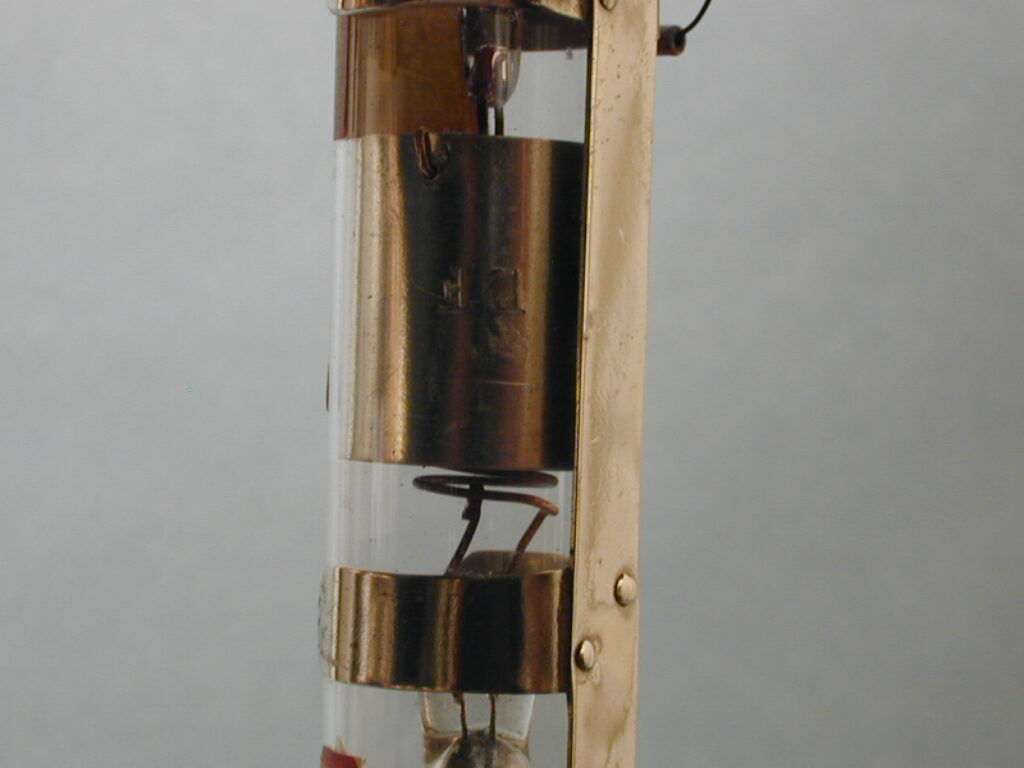
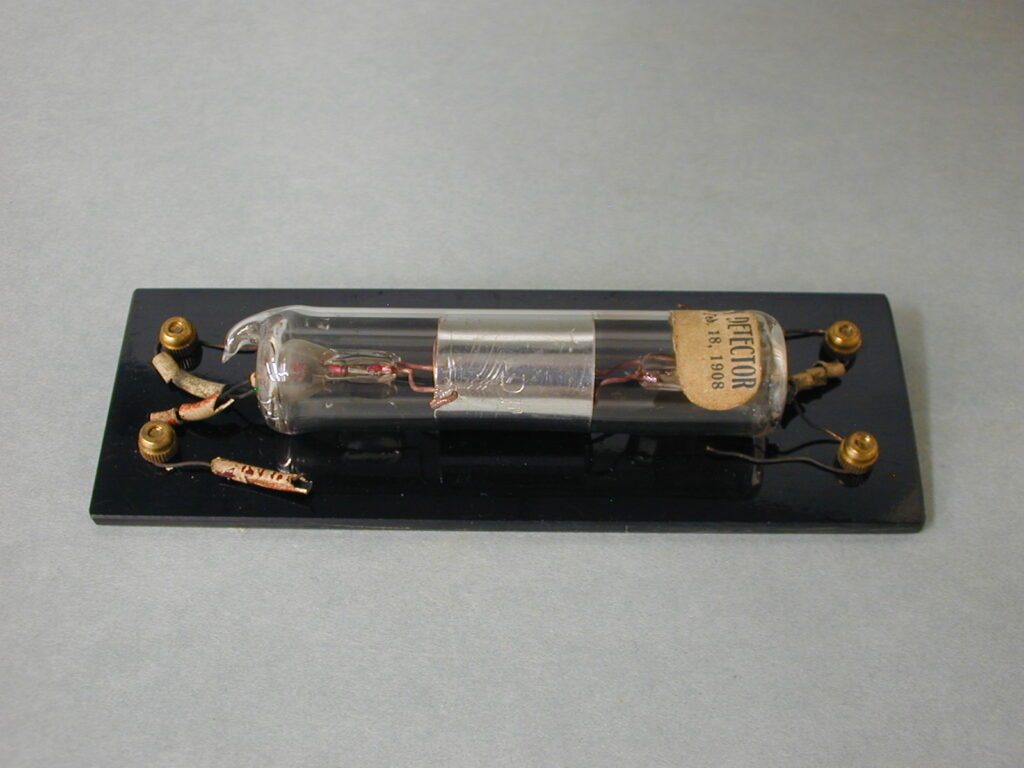
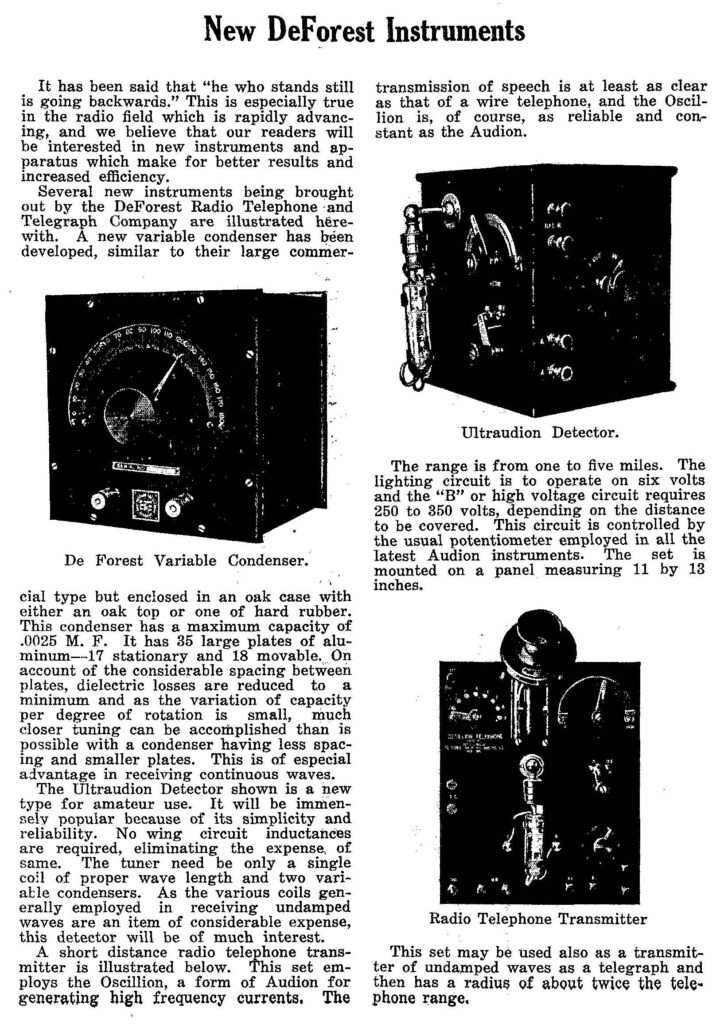
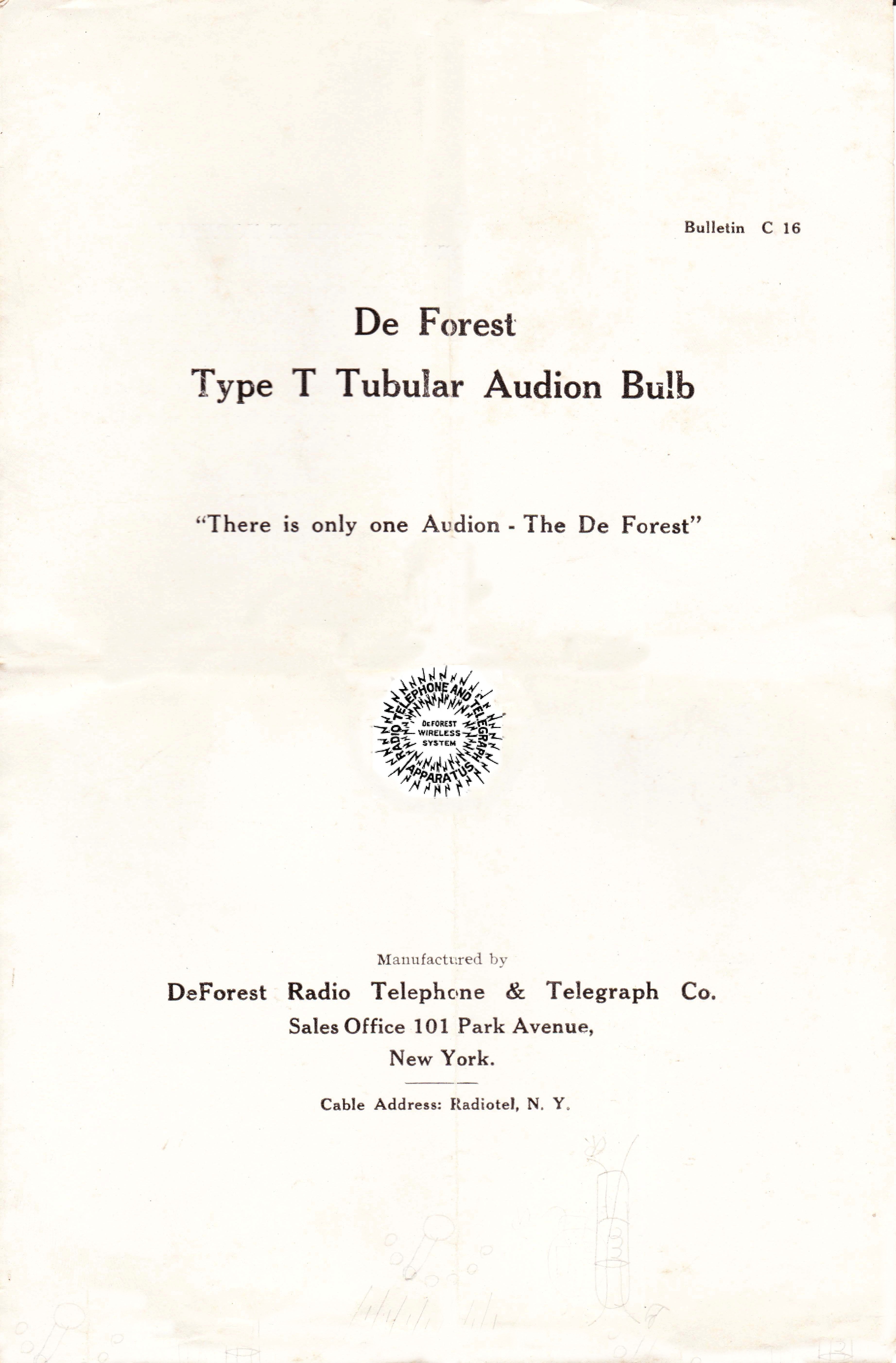
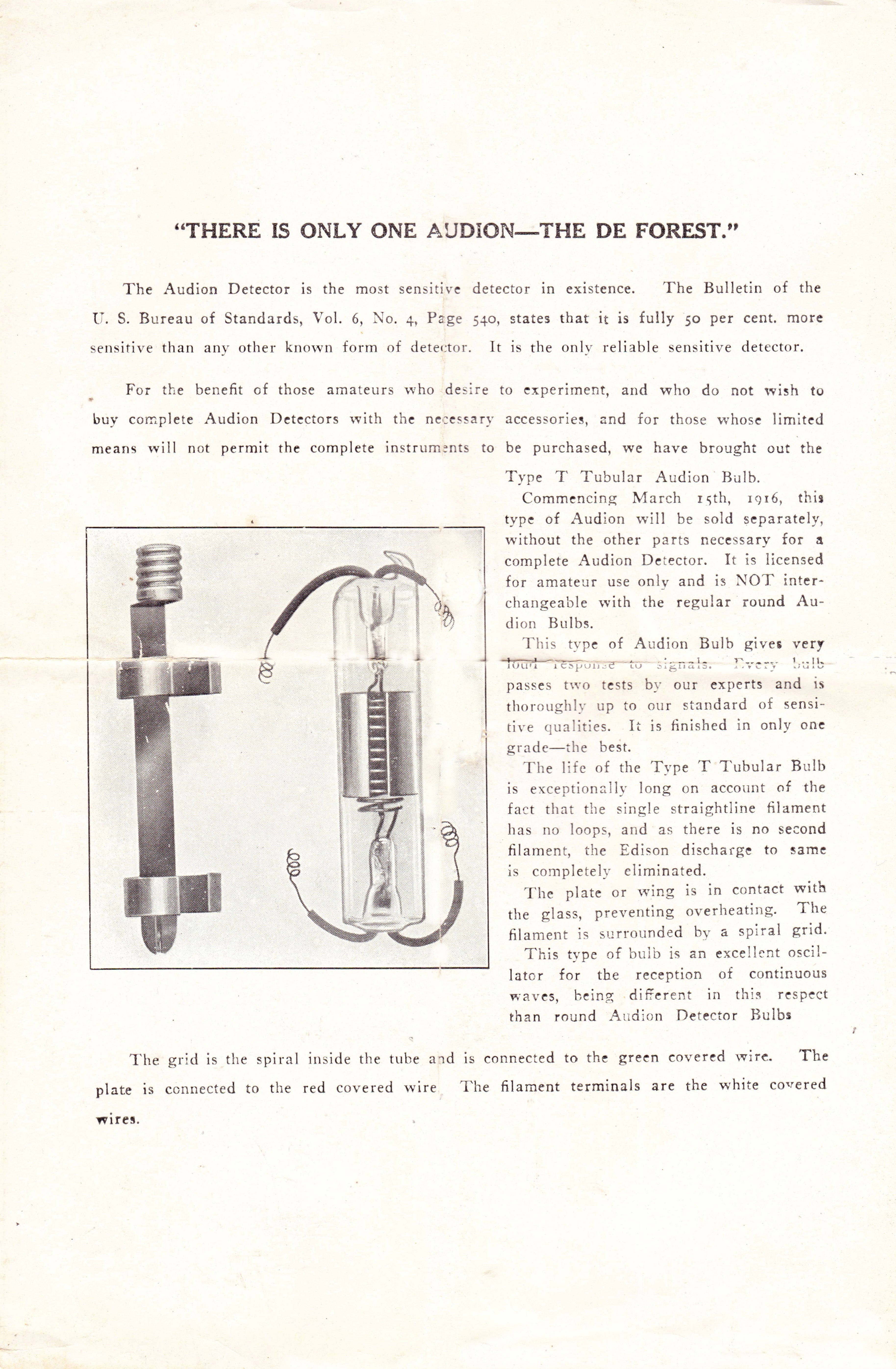
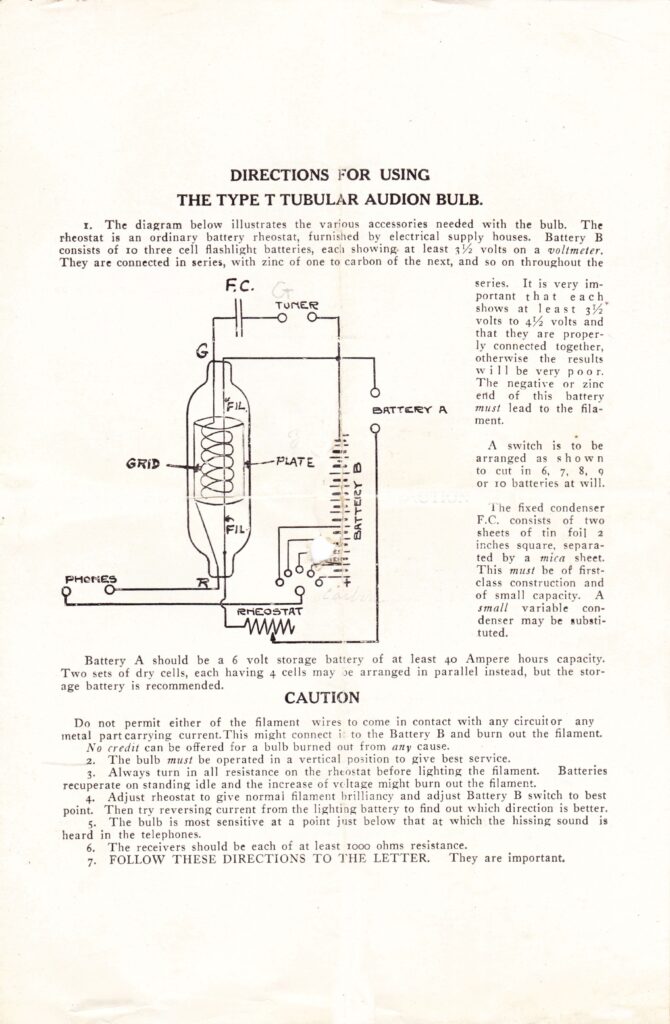
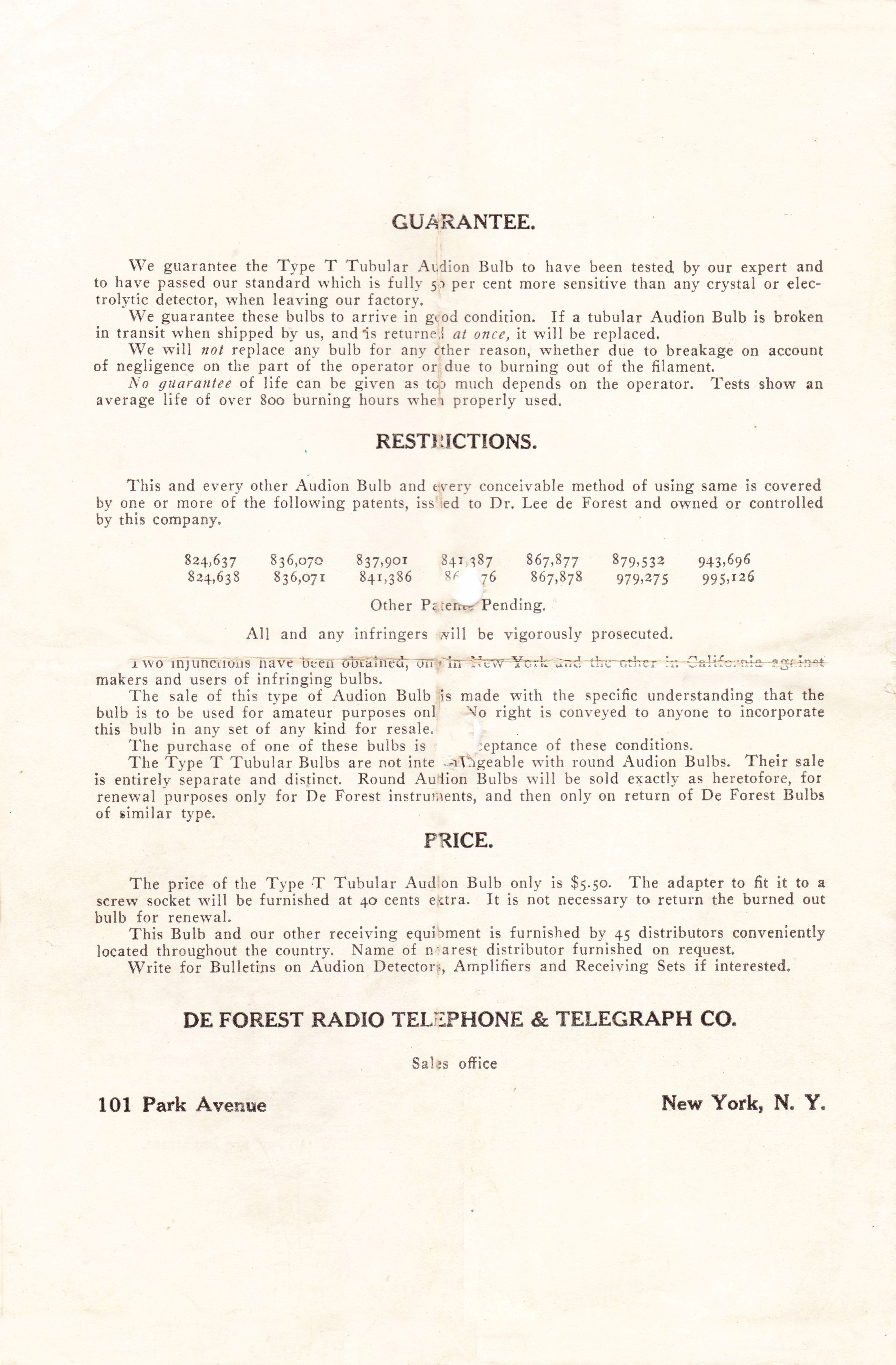
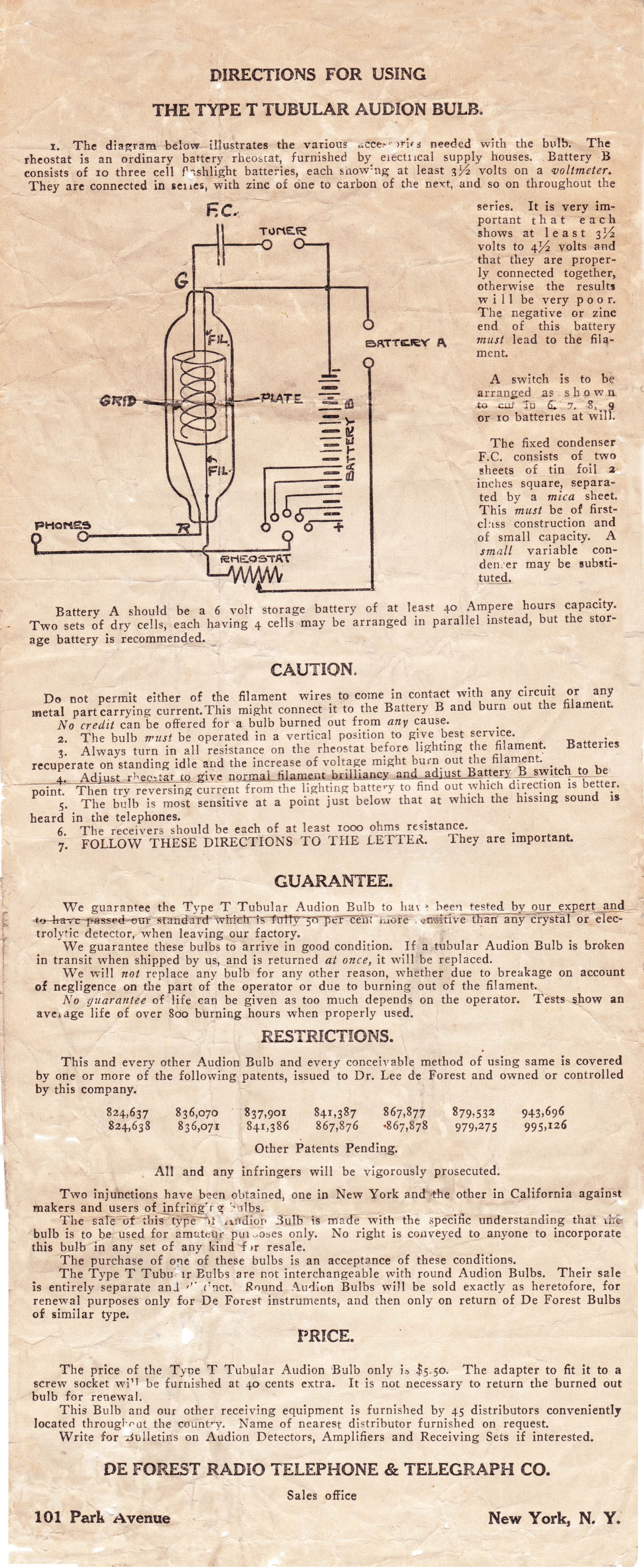
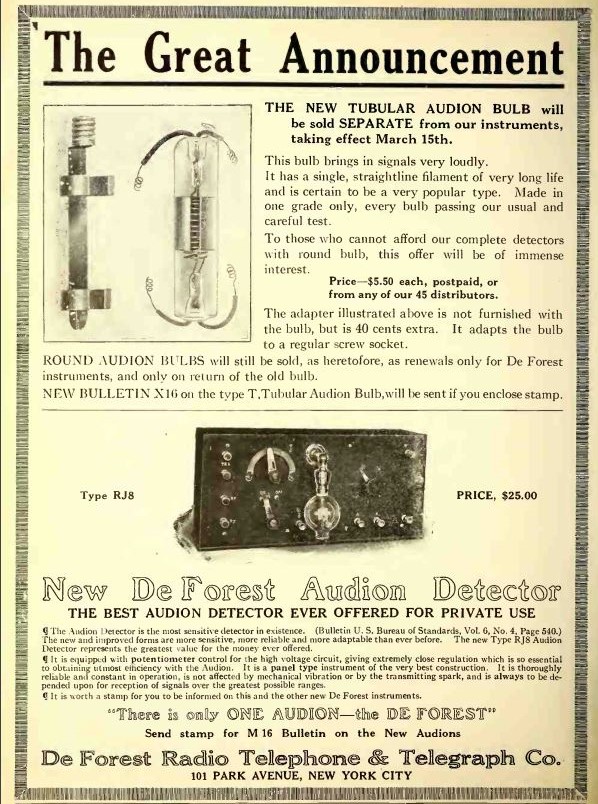
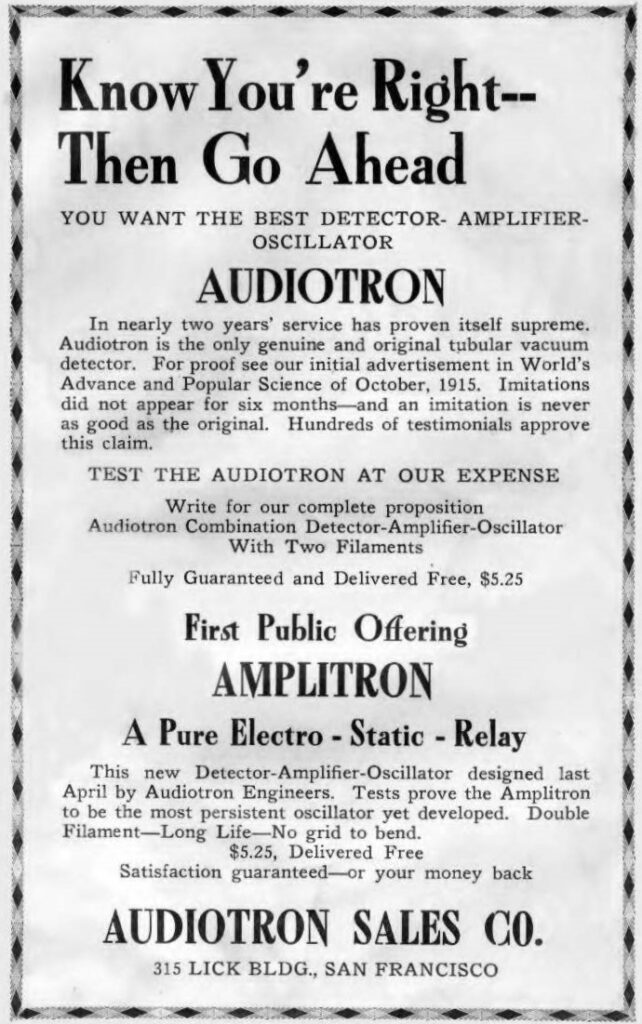
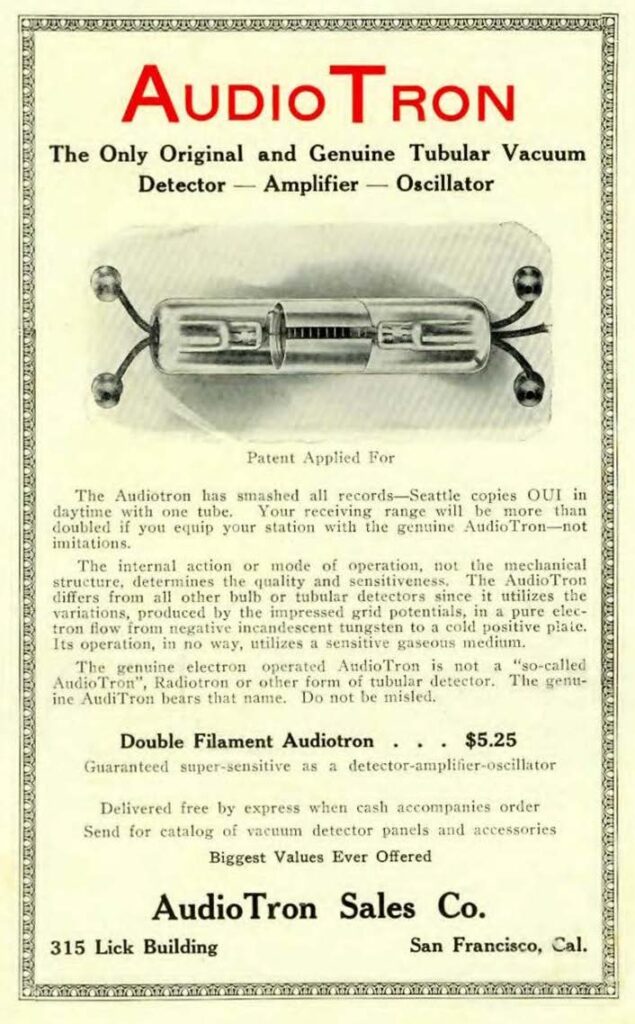
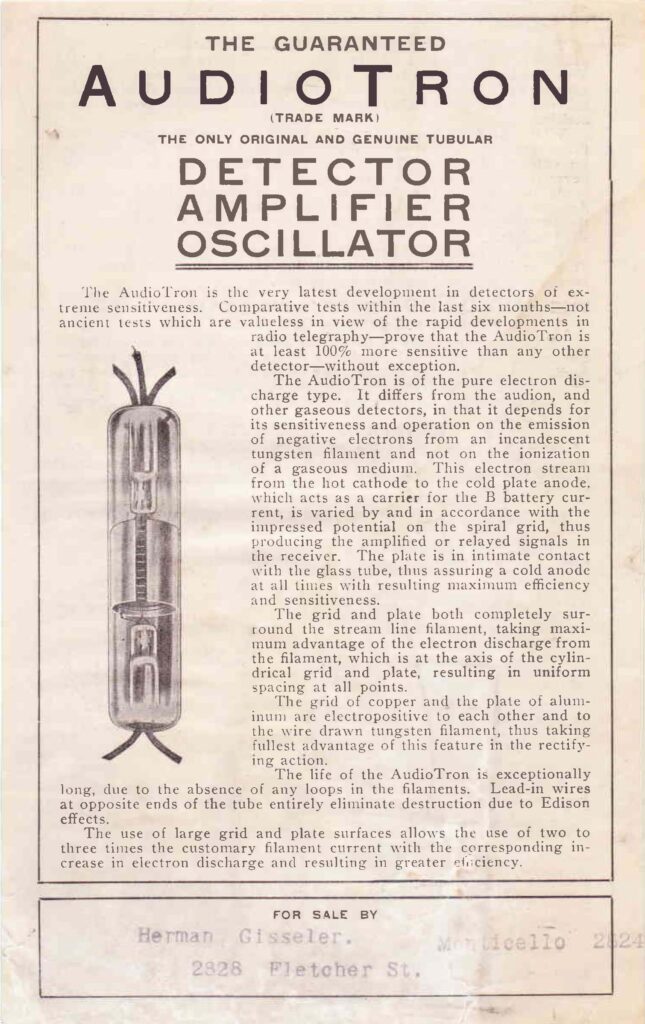
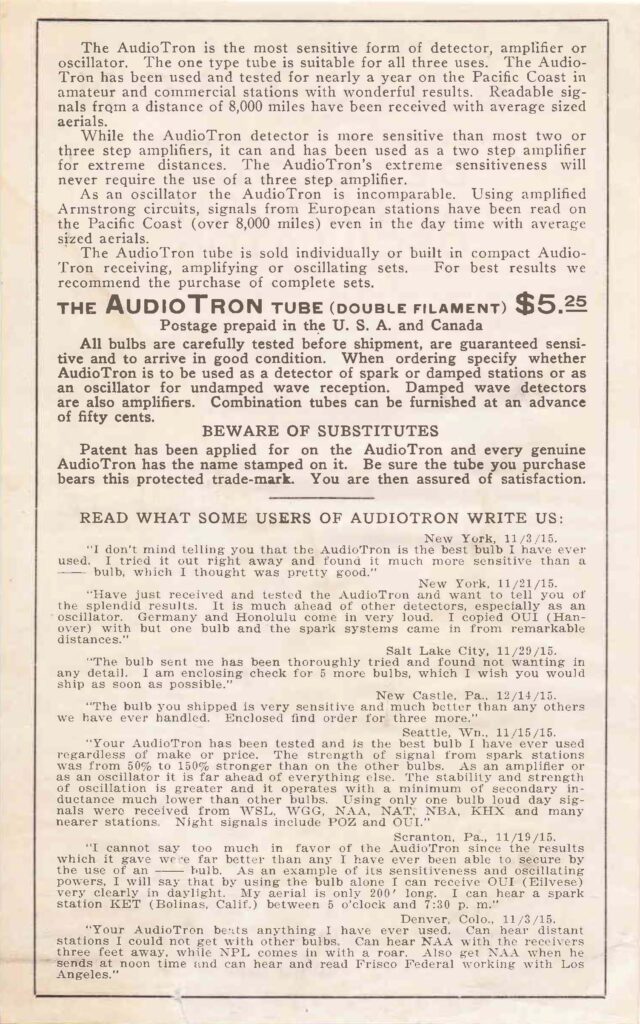
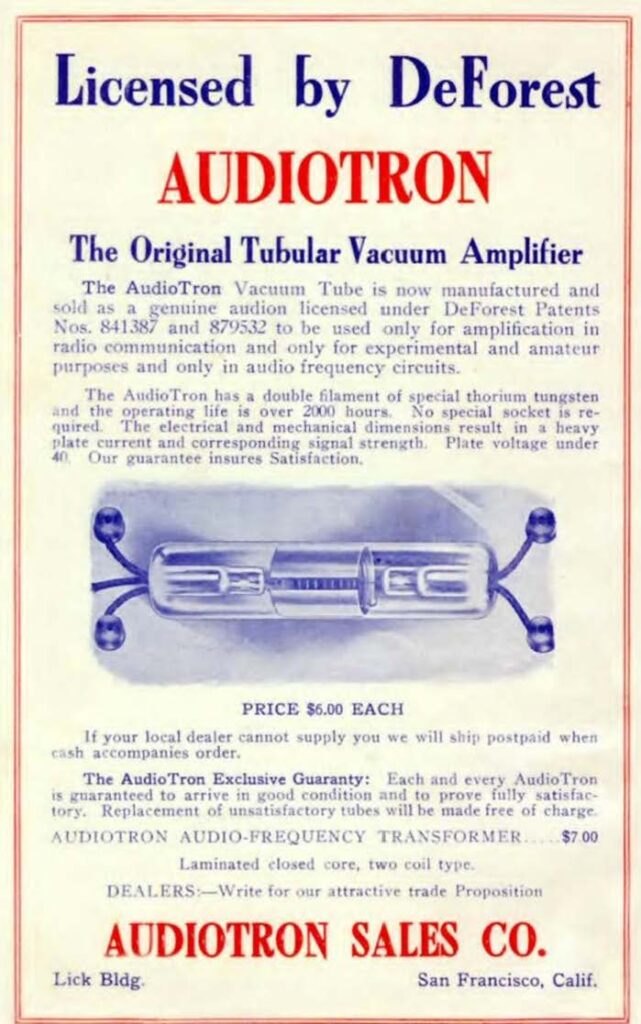
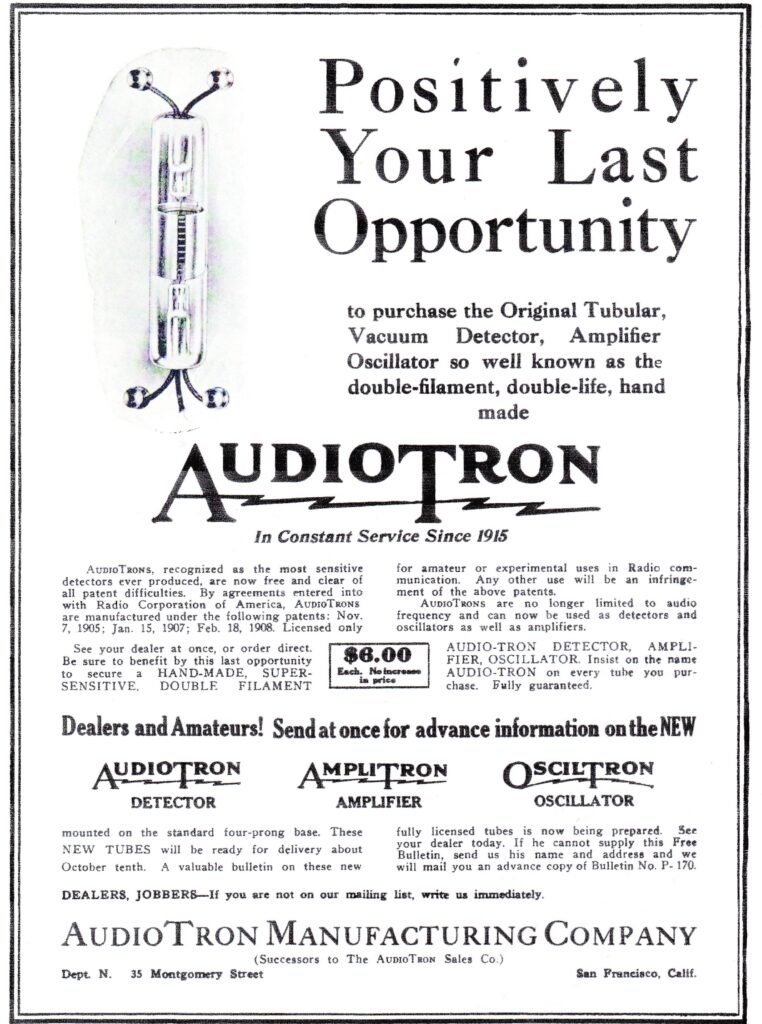
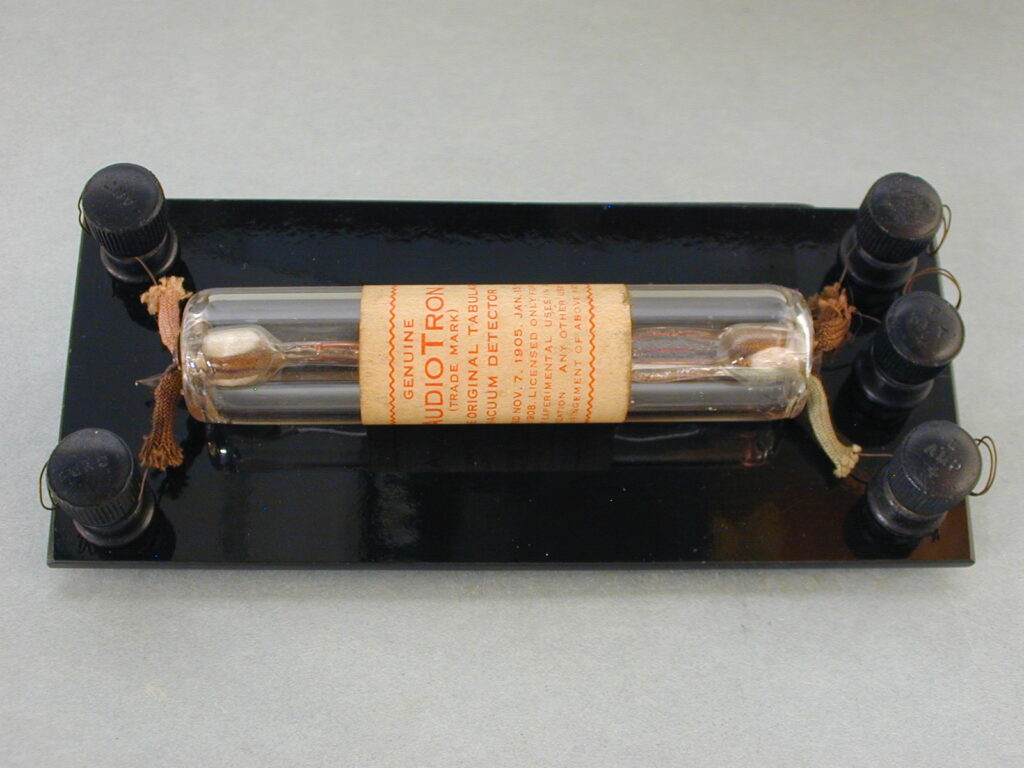
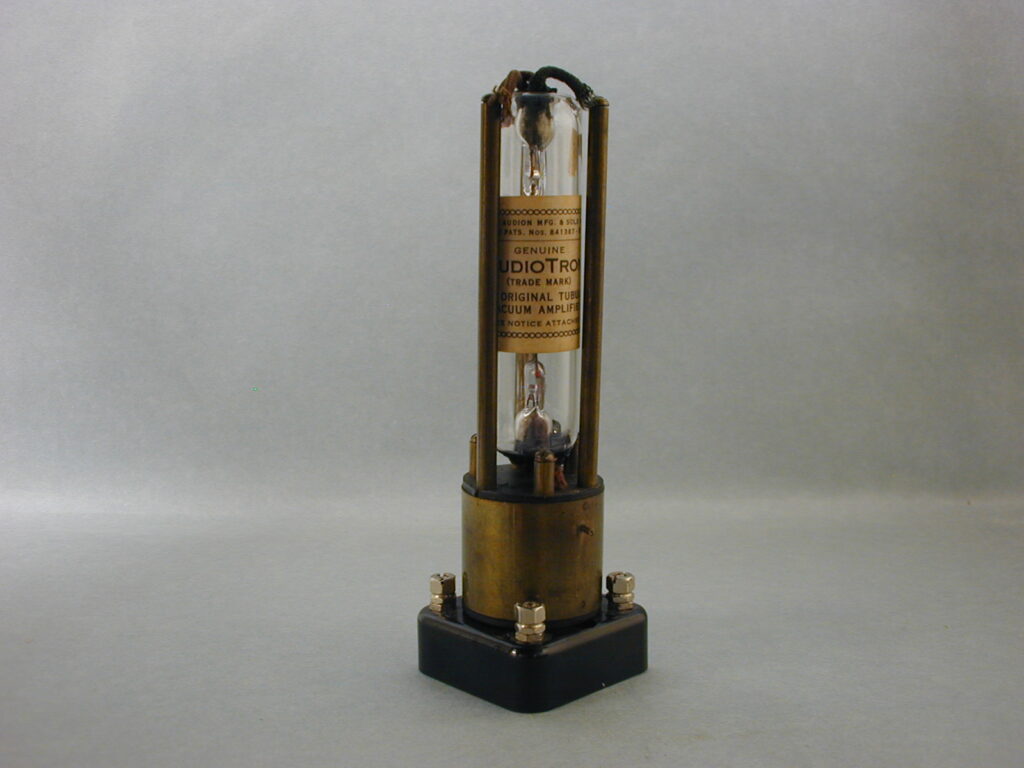
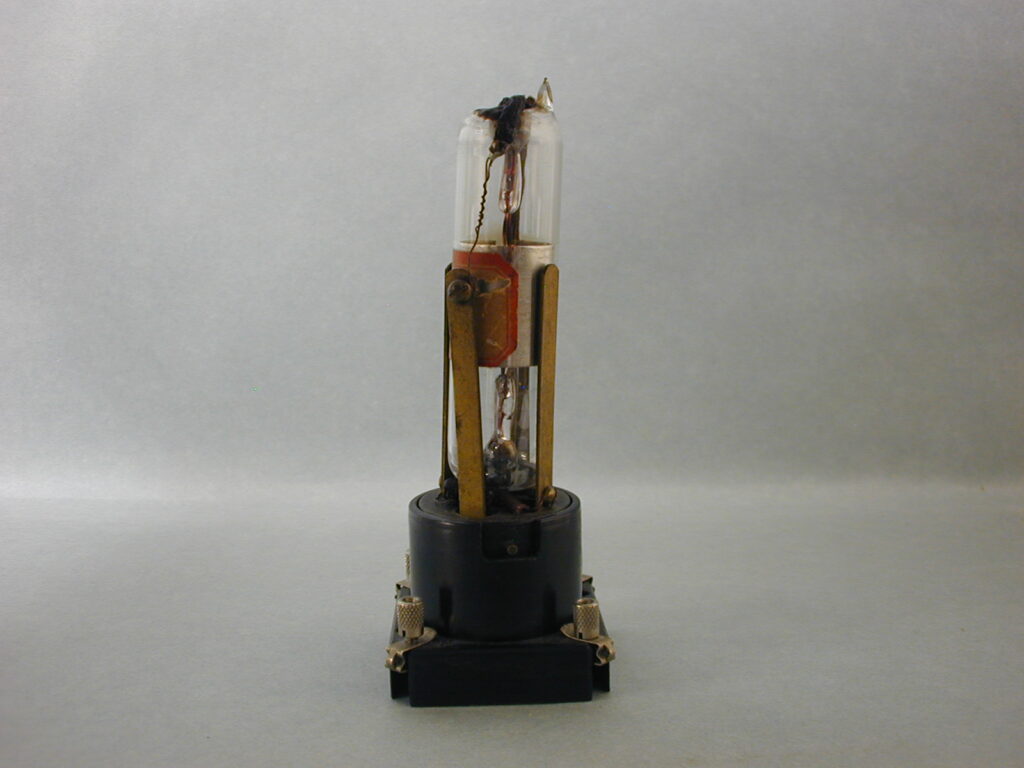
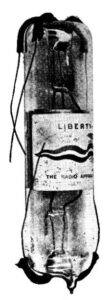
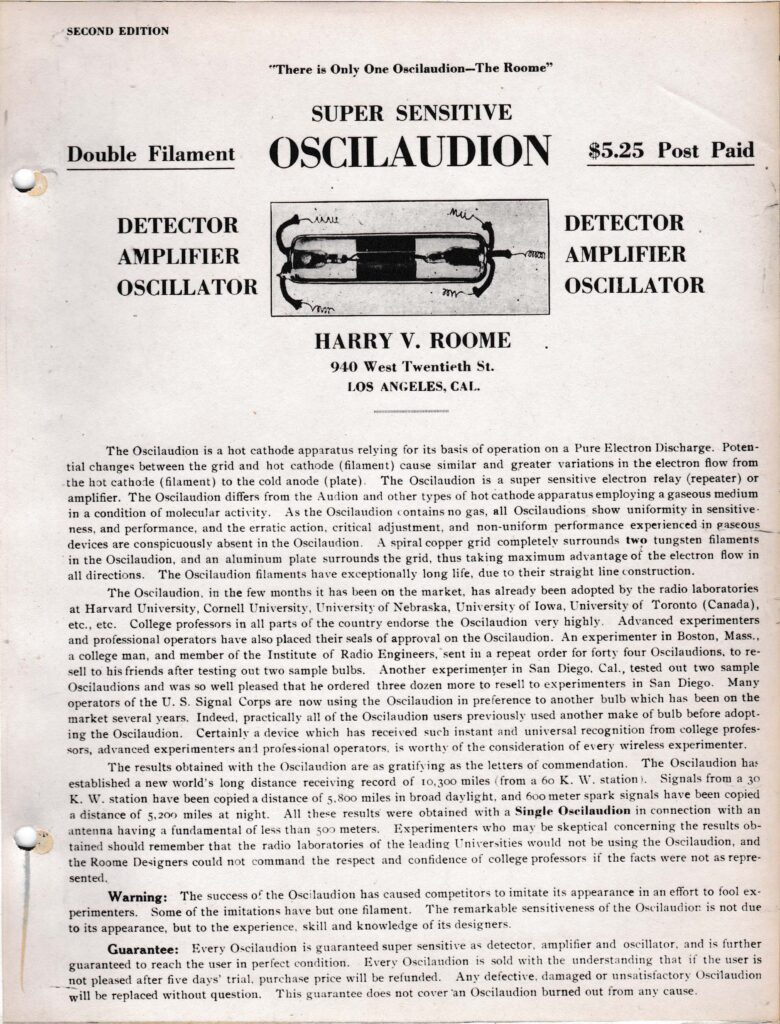
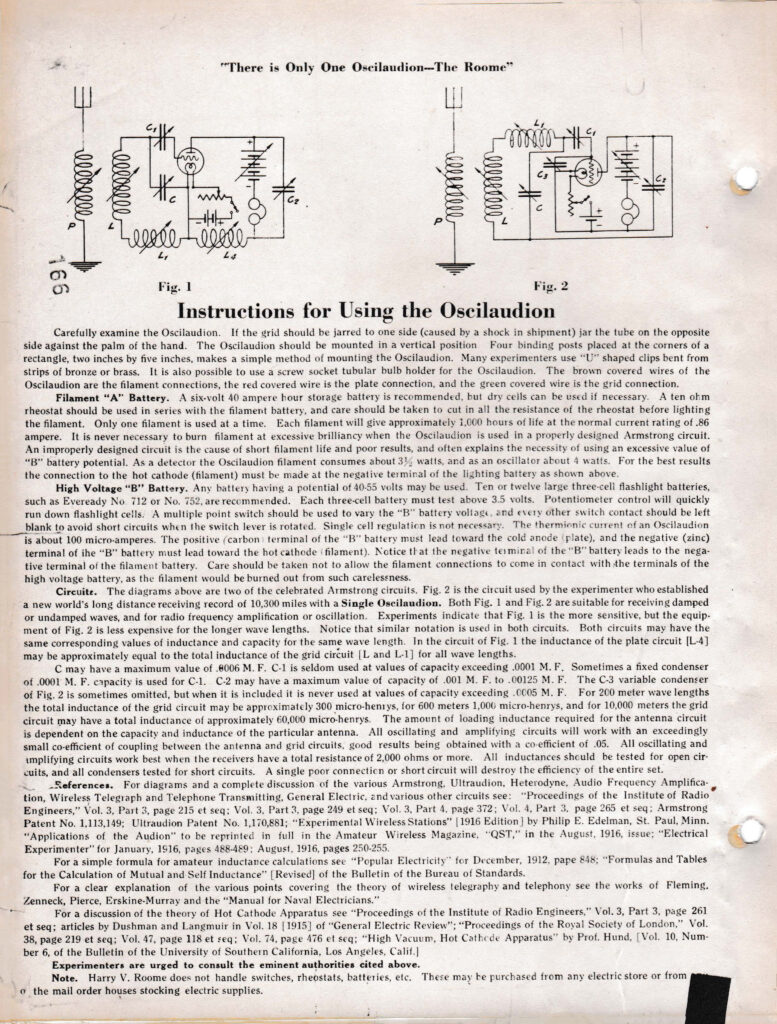
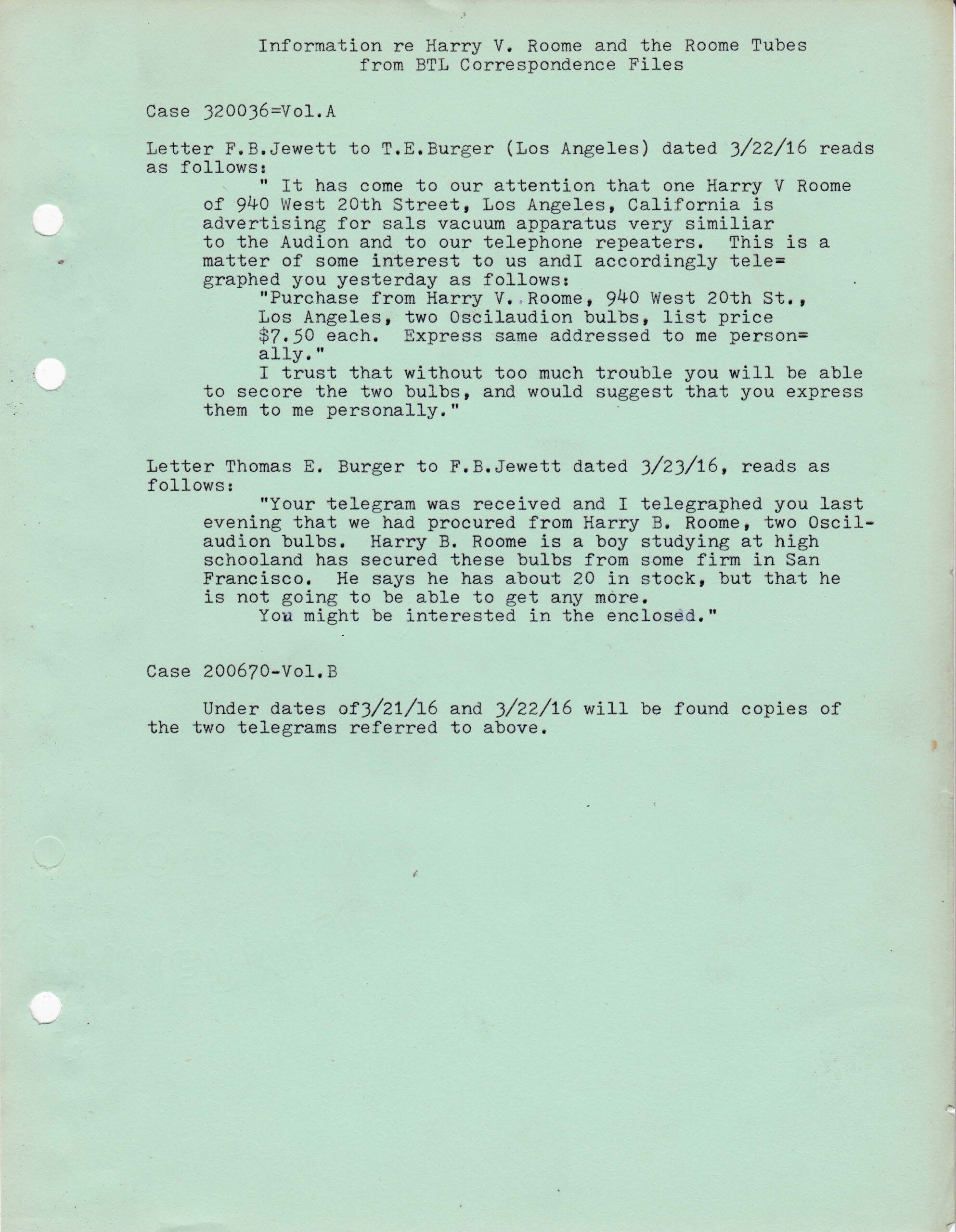

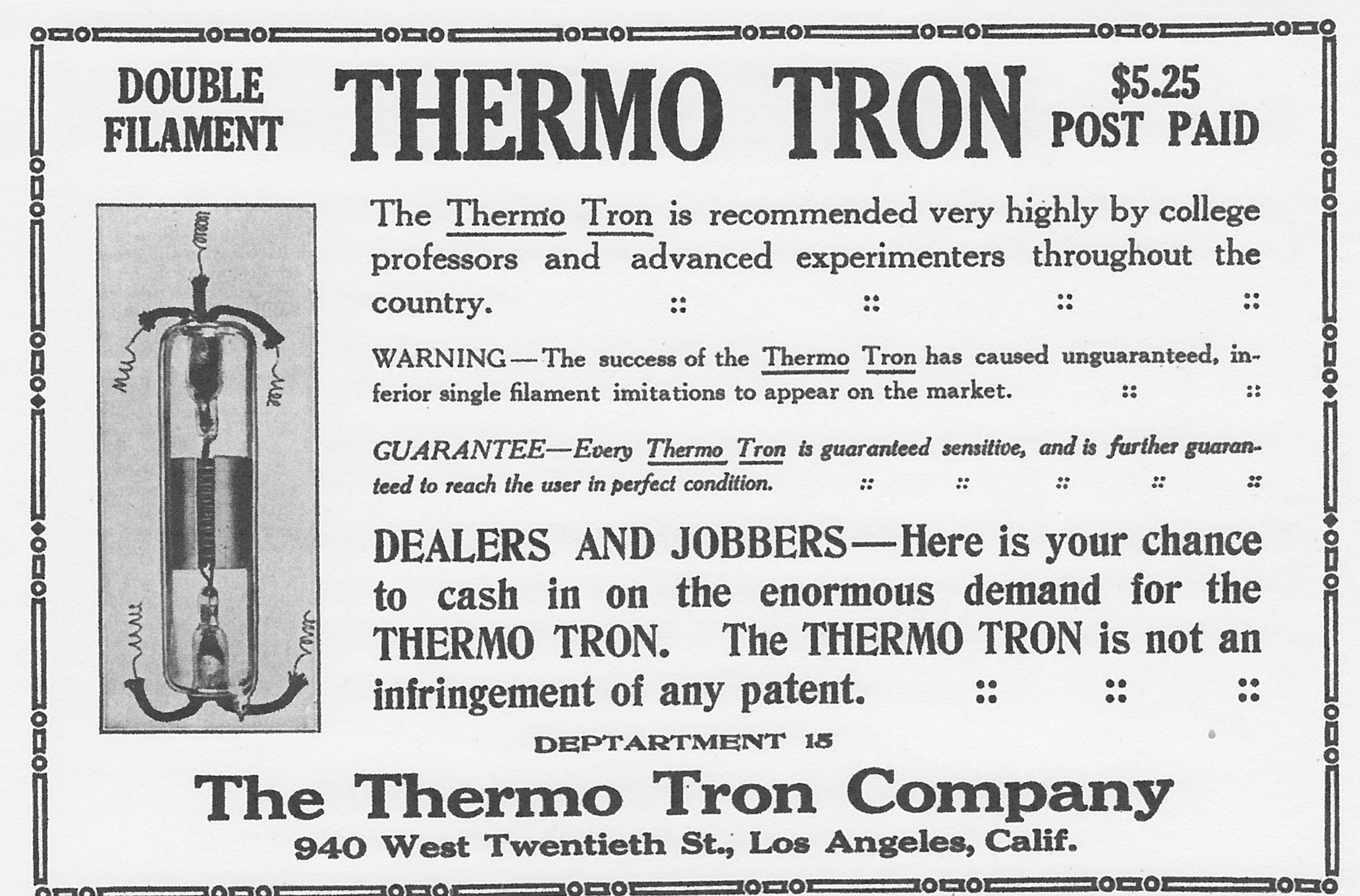
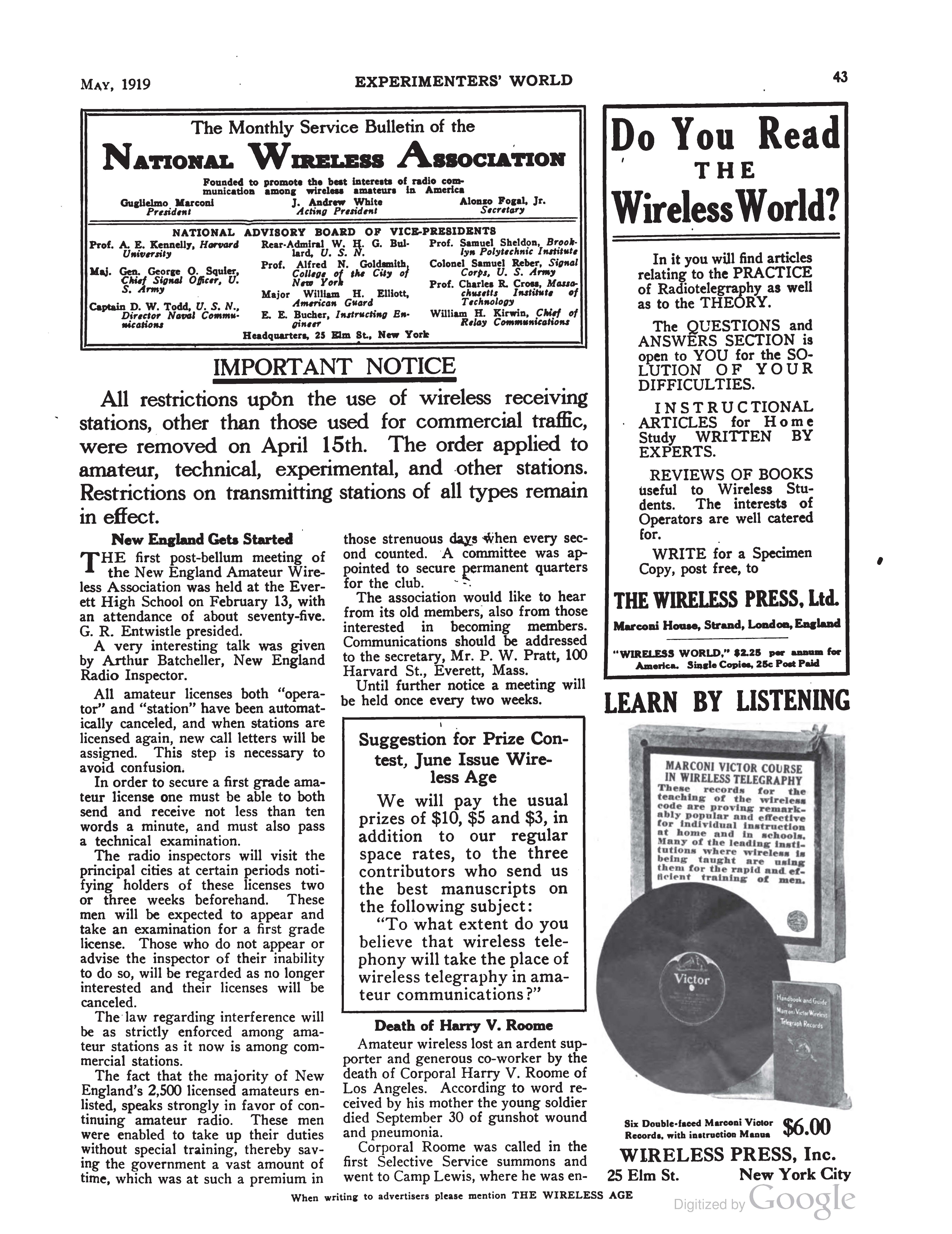
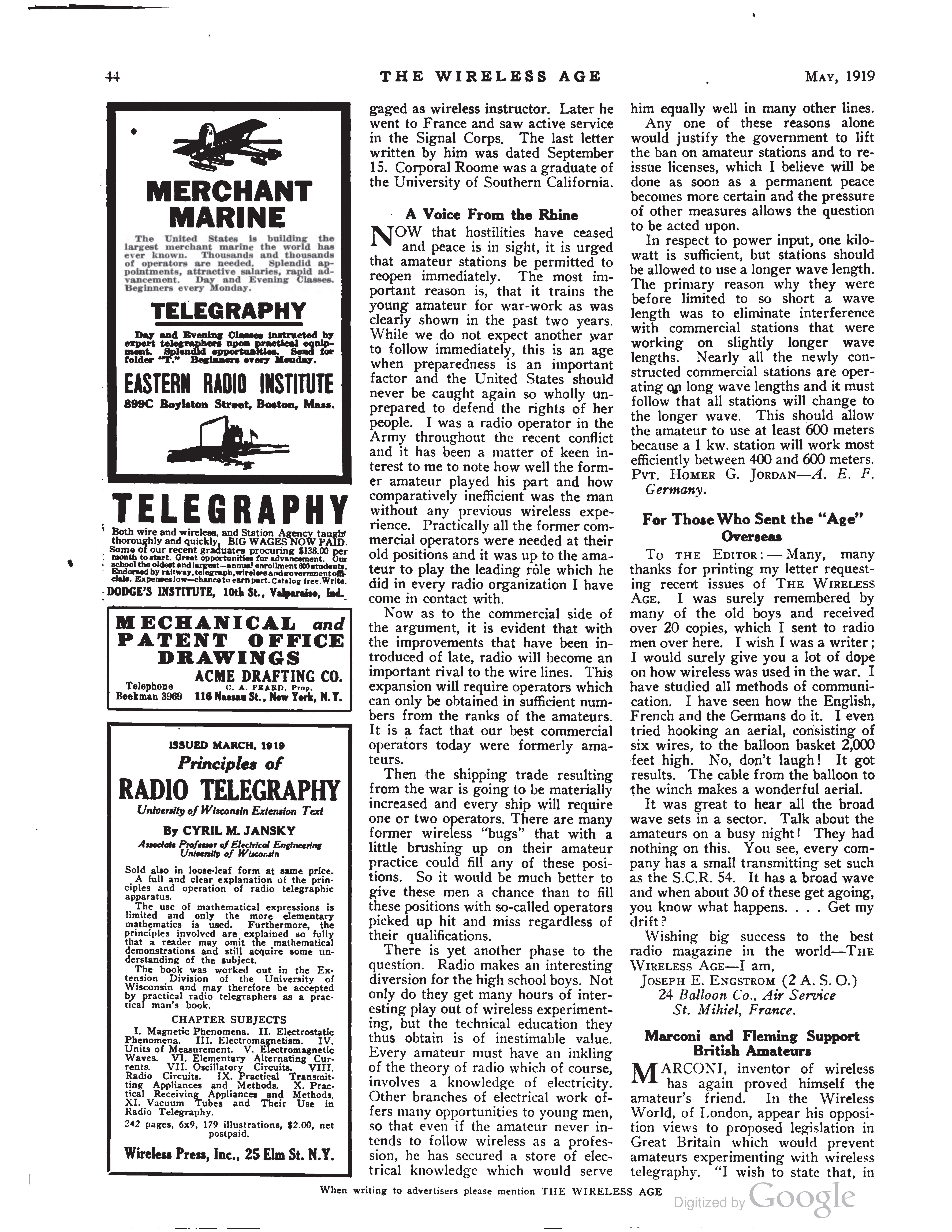
More Below
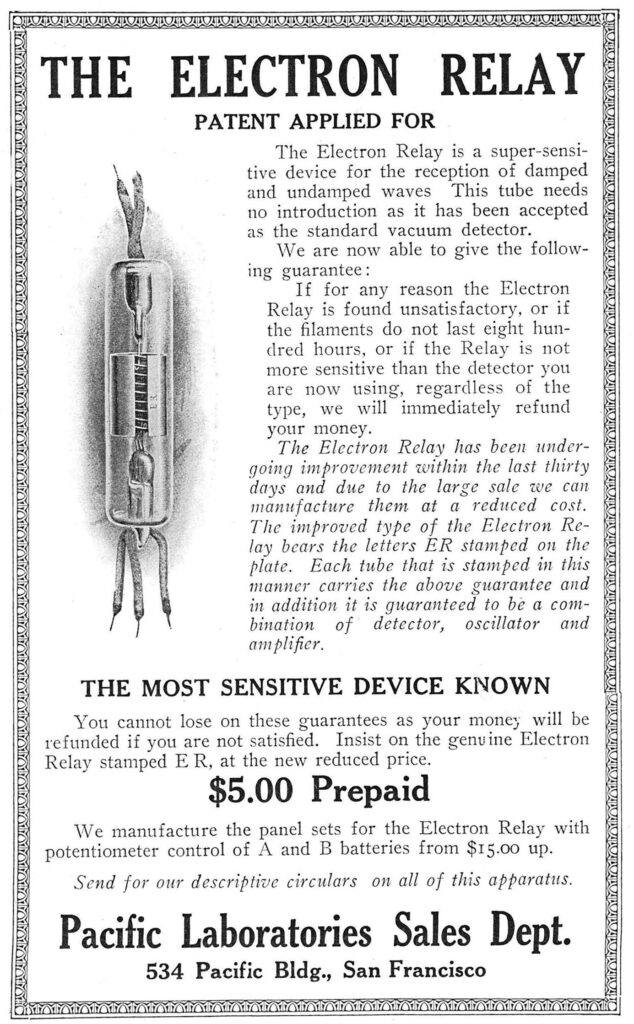
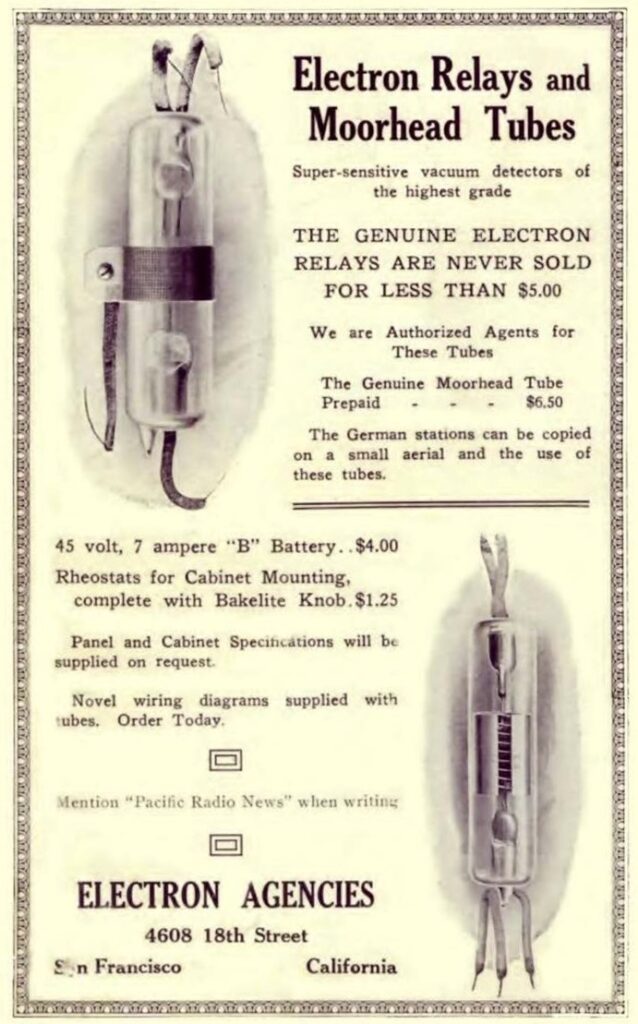
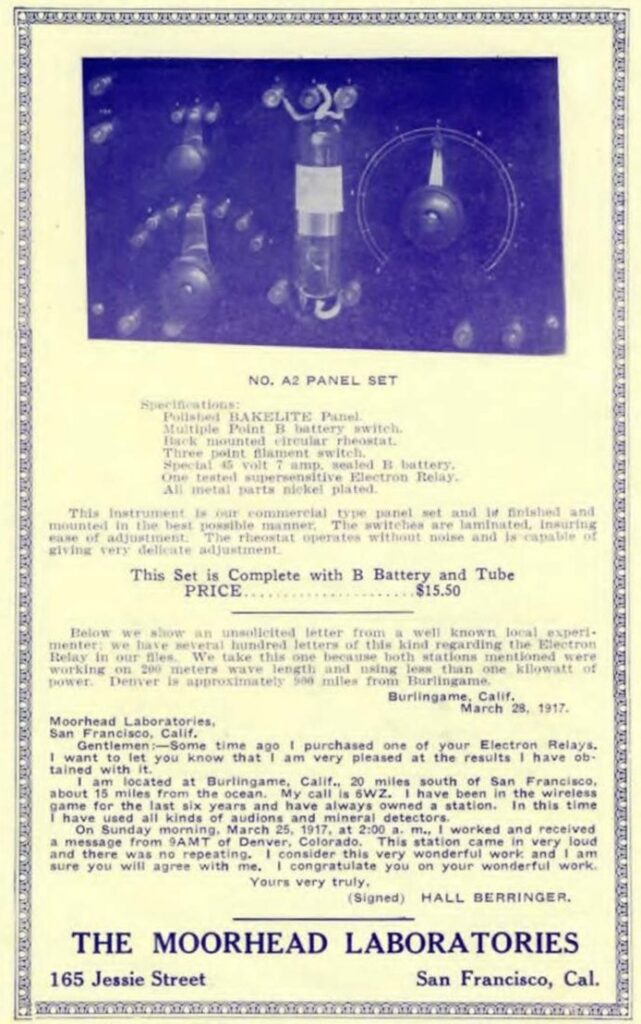
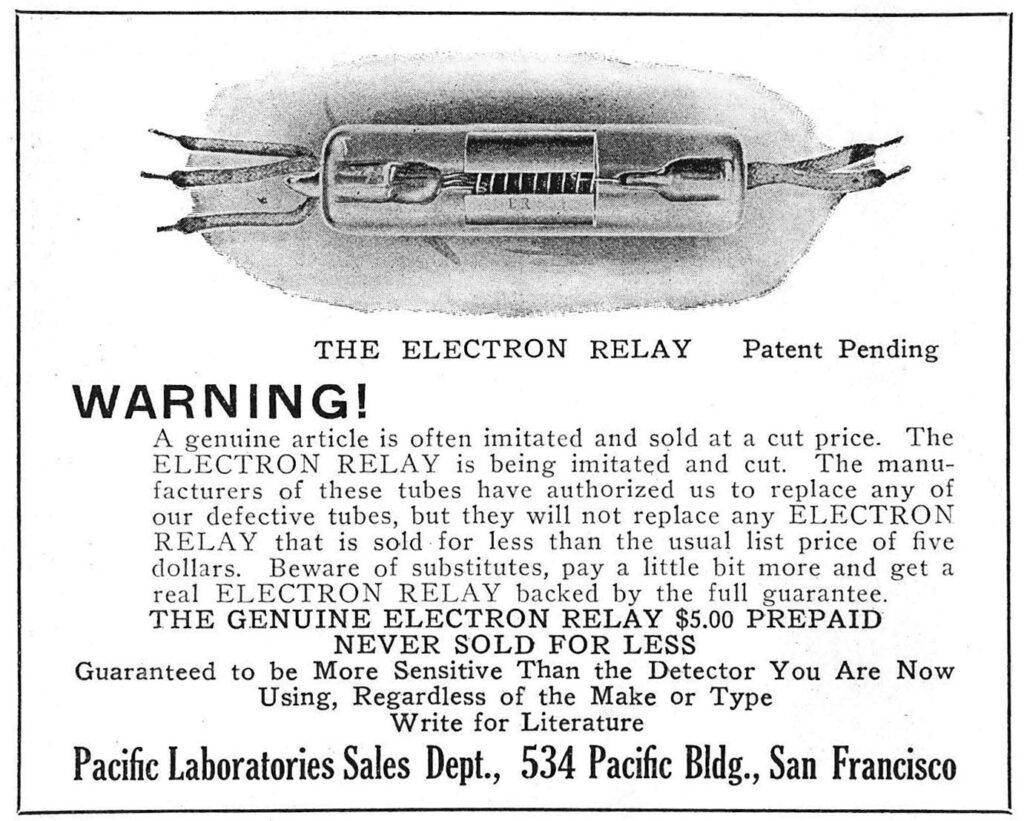
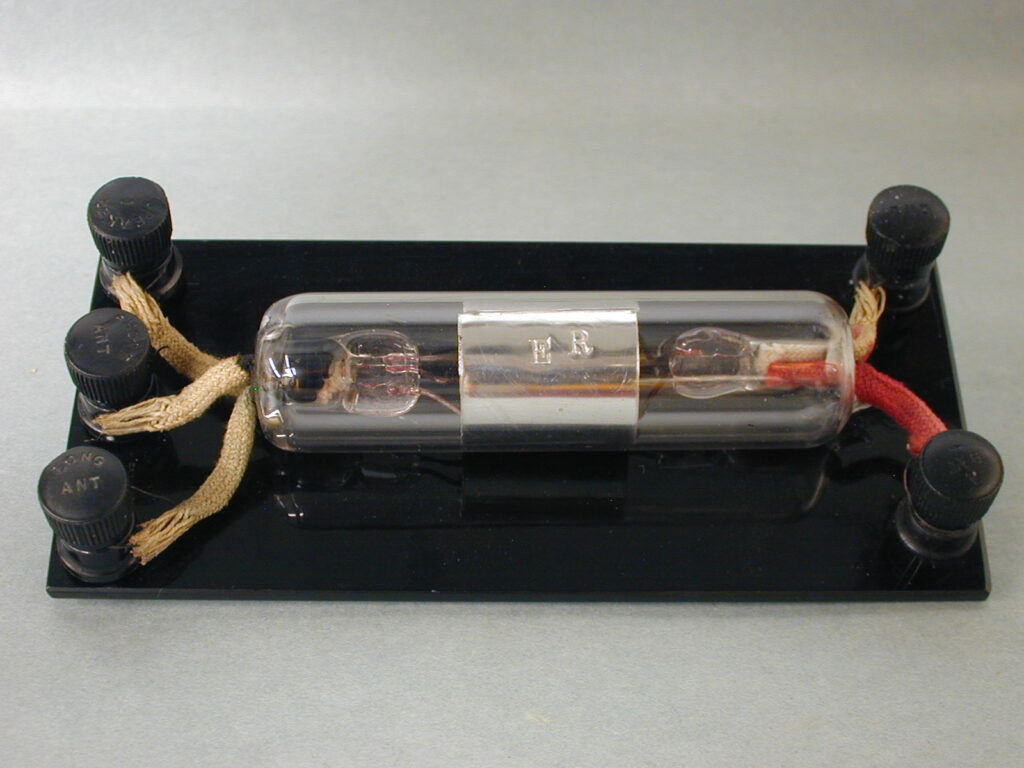

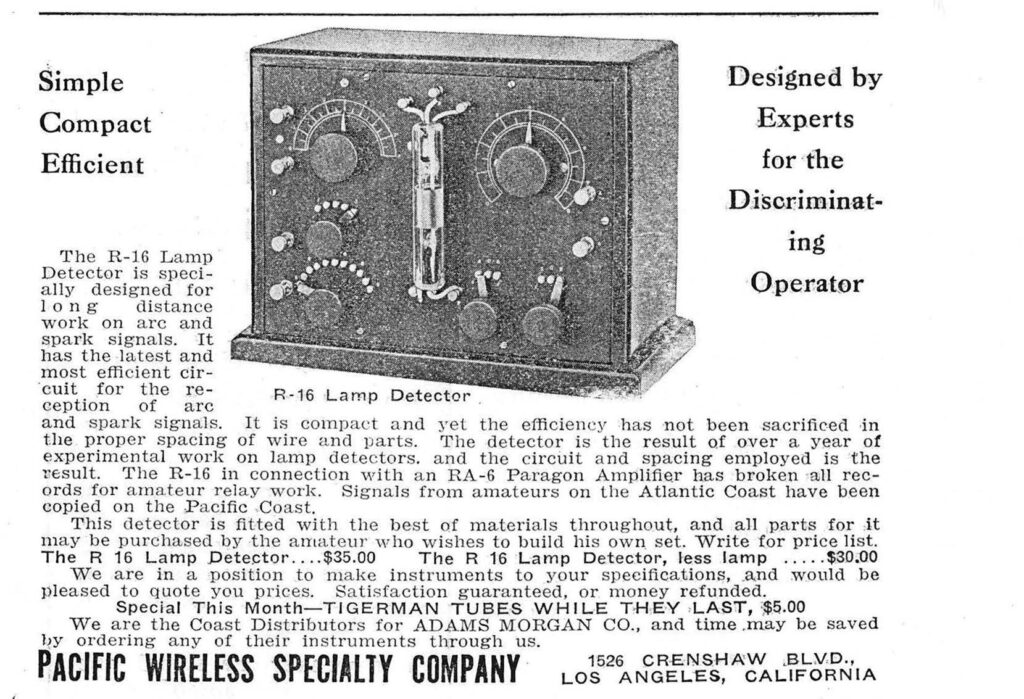
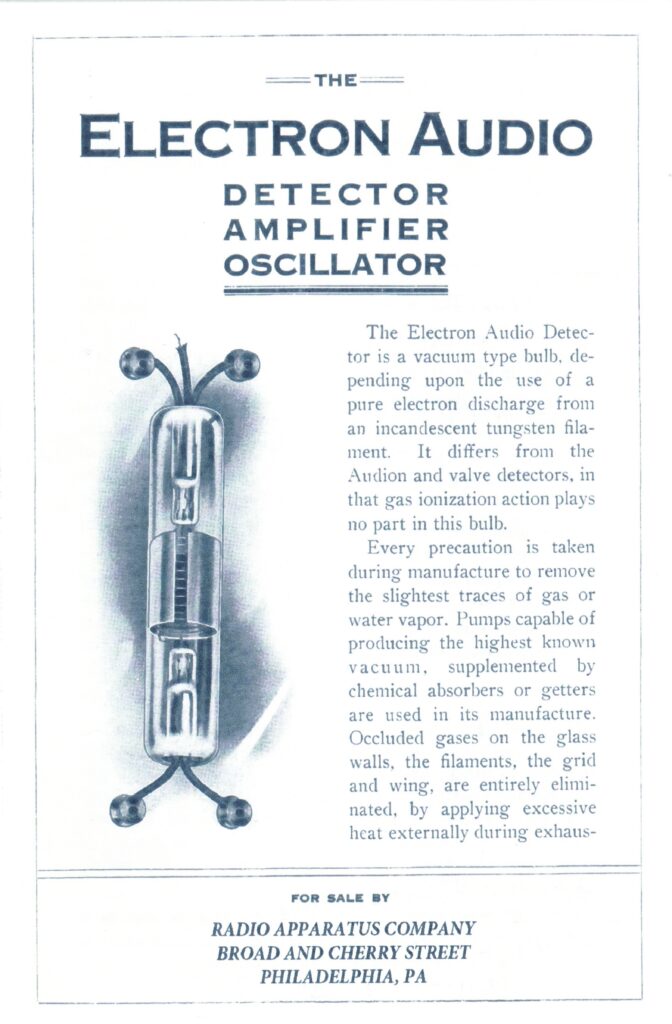
Below find the descriptions of the pictures above.
Fig. 1. 1916 De Forest type T audion with the factory adapter to candelabra standard screw base. It has the De Forest factory adapter to candelabra standard screw base. The period base is a Bryant.
Fig. 2. Same tube as fig. 1 with a closeup of the inner structure and a look at the DF stamping.
Fig. 3. Another 1916 type T audion this time with the DF stamping and a paper label stating “Audion Detector” and the normal date of Feb., 18th, 1908 when the patent was issued.
Fig. 4. De Forest also made the same tube called the ultra audion type T which meant it was to be used in his Ultra Audion control box sold separately.
Figs. 5-1 – 5-4. To this authors knowledge, the only original De Forest type T audio bulletin # C-16. It explains in detail the hook-up, guarantee, price with pictures of the tube and factory adapter.
Fig. 6. Again, to this authors knowledge, this is the only De Forest type T audion instruction paper that would have been included in the shipping box.
Fig. 7. The great announcement ad that mentions the type T audion with the factory adapter.
Fig. 8. Early ad for the Cunningham Audiotron. Notice Audiotron is all one word. This will be changed later to make it 2 words in a short time.
Fig. 9. Now the Cunningham Audio Tron is 2 words.
Fig. 10-1 & 10-2. This authors original Audio Tron flyer ad.
Fig. 11. Cunningham now claims that he has a license from De Forest to sell his tube.
Fig. 12. This ad states “This is Your Last Chance” to get his Audio Tron. The ad was placed within a matter of days when De Forest, Moorhead, and all the other makers would be out of business when RCA took over all patents and had the money to enforce them.
Fig. 13. Here is a red label Cunningham Audiotron with double filaments.
Fig. 14. Shown here is a Cunningham black label Audiotron with double filaments.
Fig. 15. This is an early Cunningham with the original store bought paper label stating “Genuine Audiotron”.
Fig. 16. A rare picture of the Liberty Valve. No one knows how many have survived?
Fig’s 17-1 & 17-2. This is a scan of an original instruction sheet for the Oscilaudion, another name for tubes Harry Roome sold.
Fig. 18. This is a 1916 letter, apparently between two persons involved in a court case talking about Roome and his sales of Oscilaudion tubes that are infringing, probably the De Forest grid patent.
Fig. 19. Another name for Roome’s infringing tube was the Oscilaudion. This was his way of avoiding legal trouble but he used the same address in Los Angeles.
Fig. 20. Thermo Tron was just another name for the same Harry V. Roome who still kept his correct address on the ad.
Figs 21-1 & 21-2. Unfortunately, Harry was called to serve in WW1 and rose to the rank of corporal. This update was sent by his mother to the Wireless Age to inform those interested of his death. Thank you for your service, Harry.
Fig. 22. Early ad for the Moorhead company Pacific Laboratories Sales Department showing his with many boasts about his Electron Relay.
Fig. 23. In this 1917 ad, Moorhead calls his company “Electron Agencies” to avoid detection.
Fig. 24. Moorhead was bold enough to over, in this case, panels with controls to house and over the correct voltage.
Fig. 25. Moorhead makes a warning himself about armatures choosing his product and no other despite the fact he was infringing himself.
Fig. 26. Moorhead Laboratories Electron Relay with ER pressed on the plate and came standard with double filaments. This ER, as this author has heard, came with a single filament but one has not been seen.
Fig. 27. The Radio Apparatus Company made control boxes but it could include a tubular tube purchased from an infringing maker.
Fig. 28. Pacific Wireless Specialty Company also made a control box and would include a tube they purchased.
Fig 29. The original ad shown here is a mystery in that the Electron Manufacturing Company of Philadelphia claimed their tube was formally called the Audio Tron. It is not clear if Cunningham made the tube and changed the name for the sake of confusion or not or if Electron Manf. did in fact make it? Probably not?
Sources:
Click on the blue hyperlinks below to view the .PDF
- “Saga of the Vacuum Tube”, Gerald Tyne, 1977.
- “Saga of the Vacuum Tube”, original series of articles that appeared in Radio News magazines. These articles reside in the Joe Gruber collection. Download here– S_V
- Figs. 1-3, 5-1 – 5-4, 6, 10-1 & 10-2, 13-15, 17-1 & 17-2, 18, & 26, & 28 appearing in the article reside in the Joe Gruber collection.
- Advertisements from various magazines like: Pacific Radio News, The Electrical Experimenter, Modern Electrics, etc.
- Figures 17-1, 17-2 & 18 are scans from the Tyne- Vanicek paper collection.
- Picture of Harry V. Roome in his US Army uniform, front & back, donated by his mother, Beatrice Roome. Here- H_F, H_B
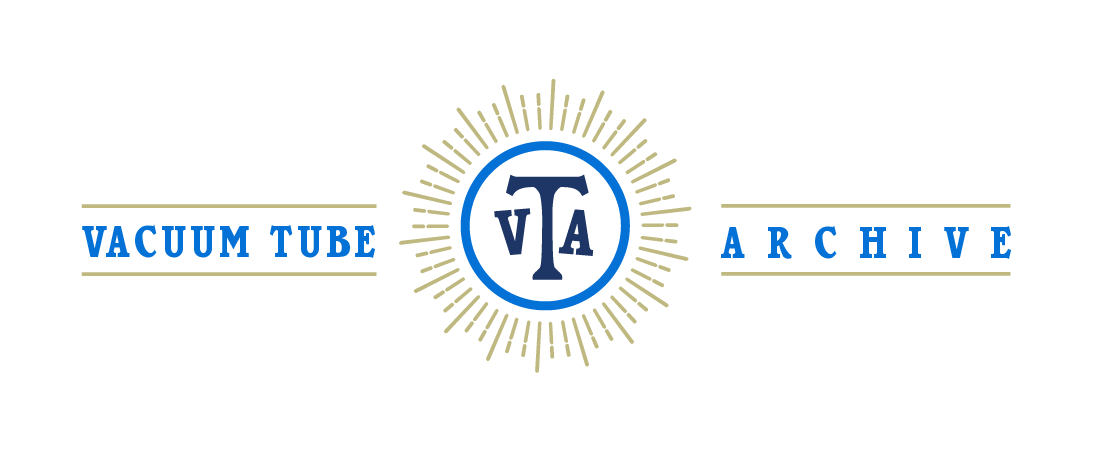
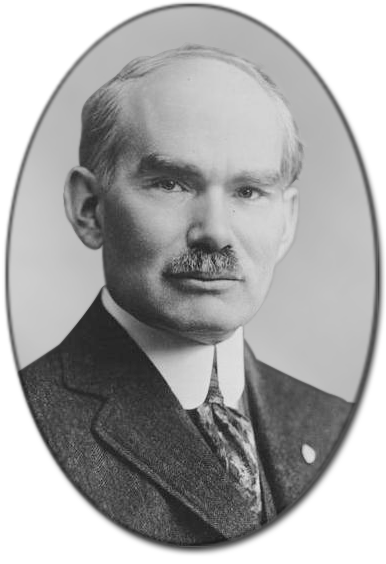
Leave a Reply